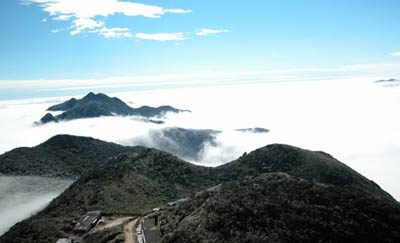 |
| Xianling Mountain |
Xianling Mountain is a cultural attraction and tourist spot towering 1km northeast of the outskirts of Yangshan county seat, Lianzhou city. Xianling (literally meaning “virtuous magistrate”) is named after Han Yu, a magistrate, one of China's finest prose writers and first among the "Eight Great Prose Masters of the Tang and Song Dynasties", who once lived in the area.
Han Yu, a literary master in the Tang Dynasty was a man demoted many times in his life. The first time, he was demoted to the position of county magistrate of Yangshan. Although he didn’t stay long in Yangshan, his influence was far reaching. The New Book of Tang says he “showed love for the people” in Yangshan. He brought mainstream Chinese culture to Yangshan and promoted the civilization of local people. He also brought advanced farming technologies practiced in central China to Yangshan, changing the hunting-based life style of the local people and promoting the local economy.
The mountain has maintained its beauty since the time of Han Yu; undulating ridges and peaks are traversed by wandering paths, murmurs of brooks flow gently in the dense forest, fish swim in pools and birds sing and play in the trees. It has long been renowned as a place for relaxation. Since the Tang Dynasty, many celebrities and scholars have left words on the cliffs, leaving today’s visitors with an abundance of historical points of interest such as the Han Wengong Reading Platform, Rest Cave, Chaoyang Cave and Typing Cliff.
Meanwhile nature has also blessed the area with unique physical features. The magical Chaoyang Cave, the meandering One Line Sky and the jubilant Water Curtain Cave are natural wonders in the truest sense. The Beishan Ancient Temple built in the Ming Dynasty stands tranquil and elegant. The cemetery of revolutionary martyrs built in the 1970s is solemn and serene. In the cemetery, trees and grass flourish and flowers are bright and beautiful, adding to the charms of Xianling Mountain.
Visitors come to the mountain throughout the year.
Beishan Ancient Temple

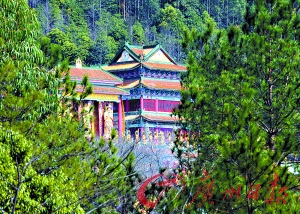
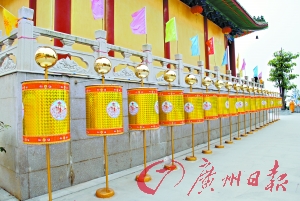

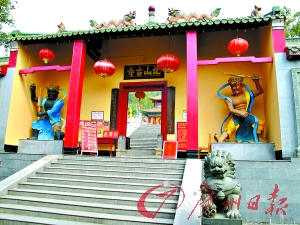
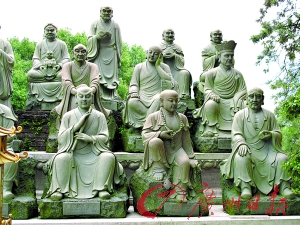
Beishan Ancient Temple
Lying at the foot of the Xianling Mountain, the temple faces north and covers about one hectare of land. With overhanging eaves and winged corners, it looks magnificent. It is surrounded by mountains and luxuriant trees, with clear water flowing down in front of the temple. Inside the temple, flowers and trees thrive and the ambience is one of elegance and serenity.
Beishan Temple is arguably the best temple in the county. Of the top ten attractions in Yangshan during the Ming and Qing dynasties, three were in the temple. They are “Waves at Yumen”, “Peach and Plum at Temple Entrance” and “Cave and Spring”.
Beishan Ancient Temple was first built during Emperor Jiajing’s reign (1522-1566) in the Ming Dynasty. Later on, it was expanded and renovated many times. The first sight as you enter the temple is the mighty “Waves at Yumen”. This mountain stream runs foaming and splashing under two bridges . After passing the Yumen Bridges and climbing up 85 stone steps, you will see an open space, with a peach and plum blossom tree on either side. This is the famous “Peach and Plum at Temple Entrance”. The temple is organized as a compound with four rows of houses. Zheng Xian Weng Shrine stands on the right of the first row, Han Daxian Shrine stands on the left, and a gate stands in the middle. Four Chinese characters “Bei Shan Ancient Temple” are carved on the archway above, and a pair of imposing stone lions squat either side of the gate. Inside the gate, there is a pond. The clear water represents the "Cave and Spring” behind the temple. A golden water bridge crosses the pond.
After the bridge, Yuandi Hall can be found along the second row of houses. To the right is Sanyuan Shrine and to the left is Qixian Shrine. On the walls of the two shrines are placed eight commemorative slabs left in the Tang, Song, Ming, and Qing dynasties, each one engraved. One features the cursive script of famous calligrapher Mi Fu, who lived during the Song Dynasty: “Qie Kan Shan Zhai” (gaze upon the mountain residence). On the third row, Wenchang Shrine stands to the right, Du Shu Song Gui Lin (an excerpt from a poem by Han Yu) stands to the left, with Guanyin Pavilion in the middle. On the fourth row, Mahavira hall, the home of three Buddha figures and 18 Arhats, is to be found. Behind the temple, there is a cave. In the cave, a sweet spring flows between stalactites. This is the cave of “Cave and Spring” and is the source of all drinking water used in the temple.
At the temple entrance, you are greeted with a panoramic view of Yangshan: green mountains, wandering rivers, neat fields, and in the distance the tall buildings of the urban area.
Han Wengong Reading Platform
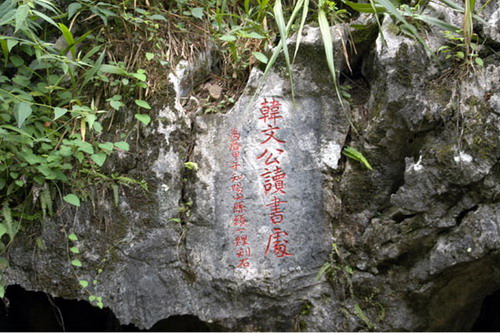 |
| Han Wengong Reading Platform |
Han Wengong Reading Platform is also known as the “Yuanlan Pavilion” and "Serene Night on the Reading Platform”. It was one of the top ten attractions of Yangshan during the Ming and Qing dynasties. It is situated in the southwestern part of the Xianling Mountain adjacent to the Rest Cave. It is said that Han Yu often read here in his spare time. People built this pavilion as a memorial to Han Yu. A small fresh spring water stream runs through the wall of the pavilion. It is cool and sweet. Shrimps play in the water.
The reading platform was first built in the 25th year of Emperor Wanli’s reign (1597) during the Ming Dynasty. It is a square pavilion with a brick and wood structure. Later on, it was rebuilt several times. In the fifth year of Emperor Chongzhen’s reign (1632) in the Ming Dynasty, the bricks were replaced with columns. In the first year of Emperor Daguang’s reign (1821) in the Qing Dynasty, a board fence was built around the structure as protection. The platform was renovated in 1964, by the Yangshan County People’s Government.
A bust of Han Yu carved in the 12th year of Emperor Honghan’s reign (1499) during the Ming Dynasty stands in the center of the pavilion. It is 1.5m high and 0.83m wide. It is the only engraved statue of Han Yu preserved in the province. Along the stone wall outside the pavilion, Han Yu’s poem “Yuan Lan” is carved: “It is not my own liking, everybody loves it, let’s come in hot summer, and drink the clear spring water.” In addition, to commemorate Han Yu, the celebrities and scholars in later dynasties left tens of inscriptions here. On the stone peak more than 30m from the pavilion, three characters “Qian Ya Biao” handwritten by Han Yu in regular script are engraved, in addition to two lines of small words: “Stand out of thousands of stones and stay noble.” The poet compared himself to the stone peak and revealed his noble spirit. Near the stone peak, the cursive script of Xiao Bingkun of the Qing Dynasty is engraved: “Xi Bi Hu”. The character “Hu” (tiger) looks powerful and vigorous.
Staying in the reading platform, you can’t help recalling the history of the area, as if Han Yu himself was sitting there peacefully reading to you.